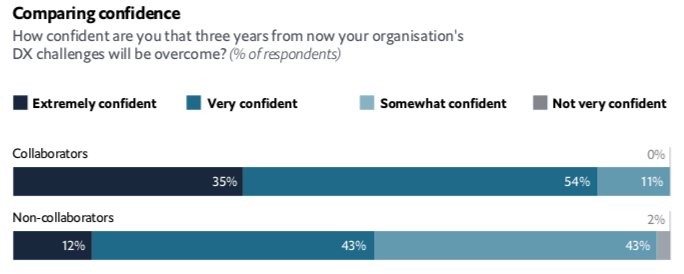It’s said there is no “i” in team, but when it comes to digital transformation, there is definitely an “i” in IT. And it might stand for ignored. A new survey on digital transformation from the Economist Intelligence Unit shows that business leaders routinely bypass IT when buying technology to support digital transformation initiatives.
A whopping two-thirds of business respondents said they never or seldom involve their IT departments when acquiring IT systems for digital transformation initiatives. Concerningly, 31 percent of non-IT respondents say IT decisions are not aligned with their digital transformation goals. They cite long procurement times and IT decisions not being flexible enough to support the business side’s goals of increased revenue and reduced costs.
Given the explosion of apps and services, organizations are obviously good at connecting systems through APIs, data warehouses, and other technologies. Where they tend to fall down is in connecting people. Both systems and people need to collaborate to successfully and efficiently drive digital transformation.
Collaboration is not a buzzword
Collaboration is about listening and building shared goals. It’s not: “You’re collaborating with me by doing what I say.” We’re probably all guilty of that sort of non-collaborating collaboration. Everyone likes things done their way (guilty!), but the Economist survey shows that those who do collaborate have better results.

Clearly this survey shows that the collaborators cohort is far more confident it can overcome challenges than the non-collaborators. Ironically, the two groups seem to agree on the top challenges: lengthy decision making, integrating new technologies, and, everyone’s favorite, internal resistance to change.
Change is hard, but possible
“We have transformed into an agile organization, with teams in cross-functional squads,” says Kalman Tiboldi, chief business innovation officer at spare parts supply-chain company TVH, in an interview with the Economist. “The product owner and delivery manager are from the business, these work with software engineers, data engineers, all with the same remit.”
Wholesale shifts in team structures like the one Tiboldi describes probably won’t happen overnight, but there are areas where business and IT should be able to get on the same page quickly:
| What the business wants | How IT can help deliver |
| New systems to reach new users | Connect data and processes from existing systems using APIs and other technology. |
| Reduce costs | Optimize cloud usage to keep costs in check. No reason to pay for something you’re not using. |
| A great customer experience | If your app/service is slow or unavailable, customer experience will definitely suffer. IT can monitor systems for availability and performance. |
Naturally, everyone in an organization should be concerned about security. A breach can be far costlier—to both the bottom line and reputation—than overpaying for cloud services. Security is an area that IT can add value, helping secure cloud configurations, managing privileged user access, and ensuring policy and regulation compliance.
As Henry Ford said, “If everyone is moving forward together, then success takes care of itself.” For digital transformation efforts to succeed, teams across an organization must work together.






